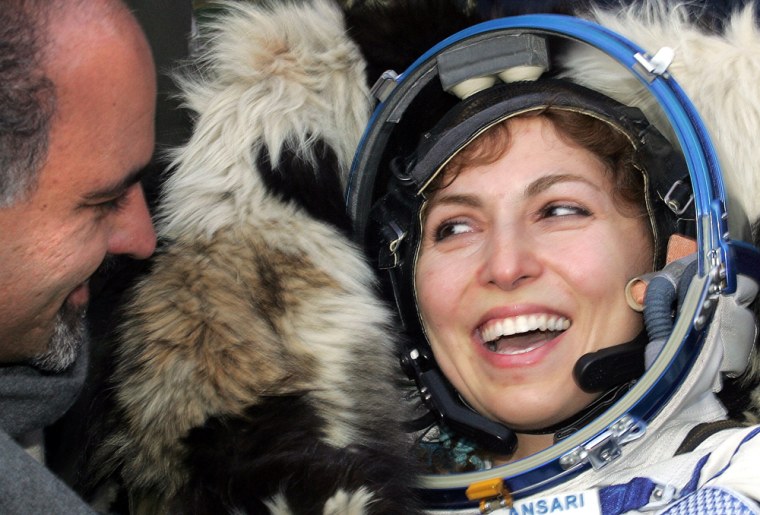With the world’s first female space tourist, U.S. entrepreneur Anousheh Ansari, safely back on Earth, a new survey spotlights the feelings of prospective travelers hungering to follow in her bootsteps.
Called the Adventurers’ Survey, the appraisal (PDF file) was done in August and September and conducted by Derek Webber, director of Spaceport Associates in Bethesda, Md., and Jane Reifert, president of Incredible Adventures Inc. of Sarasota, Fla.
The survey was done online via the Web site of Incredible Adventures. Nearly 1,000 responses were obtained and analyzed.
In taking an early look at the survey results, it “provides some much-needed customer perception feedback to those who are putting their first space tourism offerings together,” Webber told Space.com. The public study uncovered several surprises, he added, especially on spacecraft architectures and perceptions about spaceports.
Reifert and Webber report that there’s an untapped market interest for personal space travel adventures. Space travel now takes its place amongst a range of other adventure packages for consideration when funds allow, they suggest, and in this context, spaceflight is regarded as the “ultimate” adventure experience.
Pricey seats
So far, orbital space tourism has been the propelled province of well-heeled millionaires. Even for projected suborbital jaunts — up to the edge of space and return to Earth — the price tag for a Virgin Galactic spaceliner seat slaps your purse or wallet for roughly $200,000.
Several key results of the space tourism survey point out:
- The prices of current space treks into suborbital and orbital are generally too high at present, with only 7 percent registering for a suborbital flight and 4 percent for an orbital adventure at current price levels.
- Suborbital flights would really take off at $25,000, and orbital flights at $500,000, if such price levels were compatible with an operator’s business plan. If price were not an issue, nearly two-thirds of the respondents would want to go on a round-the-moon adventure.
- A large proportion of those surveyed don’t have a firm idea about their preferred design of the tourism spacecraft. But of those who stated an opinion, there was surprising agreement. A majority of adventurers wanted either a direct vertical launch or a “horizontal all the way” approach, with takeoff suspended under a mother craft coming in third.
- Spaceports for a suborbital flight do not seem to matter. The survey indicated that 48 percent of those polled would go “anywhere” for the experience, while another 31 percent would go “anywhere provided it was in their country.” It should be noted in this context that 63 percent of the respondents taking the survey were from the United States.
- In terms of orbital tourism flights, upwards of 70 percent surveyed would be happy with two weeks or less. Regarding spacewalking, 88 percent were interested in an out-the-hatch stroll, but only 14 percent would be willing to pay a 50 percent premium for the opportunity. Only 21 percent indicated the need for a hotel/space station destination on their orbital trip, but of these, most would pay up to a 30 percent premium for the facility.
Four for four
Returning to Earth late last month, Anousheh Ansari is the fourth pay-per-view person to plunk down some $20 million to climb aboard the international space station. Her flight was made possible via a deal arranged between Space Adventures, a U.S.-based space tourism firm, and the Russian Federal Space Agency.
Saluting Ansari’s flight, Webber called the space trek a “superbly well-managed exercise”, one that showcased her dedication and commitment to the new space tourism industry.
“It’s always good to be able to add another successful space tourism experience to the database,” Webber added. Starting with Dennis Tito’s excursion in 2001, there are now four for four successes, thanks to Russian space tourism operations, he noted, counting Mark Shuttleworth in 2002, Gregory Olsen in 2005, and Anousheh Ansari in 2006.
“I look forward to the time when we can start including U.S. orbital space tourism flights in the database. At least the U.S. suborbital industry is getting closer to reality,” Webber observed, pointing out that NASA’s recent Commercial Orbital Transportation Services awards — contracting private firms to send cargo and crew to the International Space Station — may well stimulate orbital space tourism.
“We must wait to see if either of the COTS winners can introduce orbital tourism as a piggyback operation with their vehicles,” Webber concluded.
For an executive summary of The Adventurers’ Survey findings, consult this PDF file.
